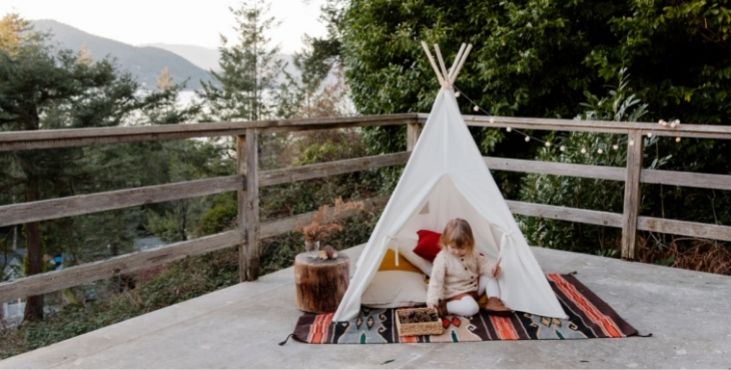Knowing how to make a tent is a skill we all should have. You never know when it might become necessary to make a tent. Imagine you’re out for a hike with your family and you’re miles from civilization and someone breaks their leg. They can’t walk and the weather starts to close in.
You’ll need to build some sort of shelter from whatever materials you have at hand. Then, once everyone is safe and dry, you can leave them while you go for help. Knowing they’re safe at least while you go and find a signal for your phone.
Or maybe the kids are bored, it’s raining and they don’t know what to do. Making a tent from household objects is a great way to inspire their imaginative minds. Either way, it’s a skill you need to learn.
How To Make Wild Tents
Maybe the situation isn’t as dramatic as we just described, maybe you and yours were out for an afternoon hike during Summertime. The weather has suddenly changed for the worse, none of you has a weatherproof jacket, so you decide to wait out the storm. You’re going to need shelter and all you have are basic materials.
That’s fine because with a little imagination, you’ll be able to cobble together a rudimentary shelter of sorts. As long as you have a rope and a tarp you’re good to go, now all you need is the right location and follow these steps.
- Locate two sturdy trees
Find two trees just far enough apart that you all can fit between them, but not so far that your rope won’t stretch between the two. - Tie the rope to each tree
Don’t tie the rope too high, your tarp needs to reach the ground on both sides. Make sure the rope is taught once it’s tied. - Hang the tarp over the rope
Lay the tarp over the rope so that both sides just reach the ground. - Secure the tarp edges
If you have them, use rope and stakes to secure the tarp through each eyelet. If you don’t, lower the sides (by retying the rope lower down) and hold the edges in place using logs, rocks or whatever is to hand.
When completed, your shelter should be A-shaped. With enough space inside for you and your party to take shelter until the weather returns to calm conditions or help arrives.
Making A Shelter From Branches
If you don’t have a tarp and you’re in woodlands use the natural resources around you to make a lean-to shelter. Find a large, sturdy tree or a large rock/boulder anything that won’t move under pressure.
Then place a large branch against the tree trunk/rock at an angle, do the same about 90 degrees from the first, this is the basis of the shelter. Lean smaller branches against these two main branches to slowly build-up an impenetrable wall of wood.
Once you’re satisfied, cover with leaves, twigs etc. The inside should shelter you temporarily from bad weather.
Making An A-Frame Shelter
Find a tree stump or tree with a low branch, anywhere you can wedge a strong branch into. Be aware of any falling branch hazards as your shelter will protect you from the worst of the weather, but not branches falling from a great height. Wedge the branch into the V-shaped nook where the low branch is growing from the tree trunk (or wedge the branch into any suitable wedge shape in the stump).
Tie two similar size branches to the one wedged in the tree you should now have an inverted V at one end connected to the first branch which is wedged into the tree. Now place long sticks along each side to create what looks like ribs of some kind. They will get shorter towards one end. Be sure to angle them so that you can fit inside with enough space around you to move about freely.
The rib-sticks need to be attached to the frame in some way, if you don’t have rope or twine, snap thin sappy twigs and rip the sinewy bark from them this can be used to lash the rib-sticks to the frame. Once all of your horizontal rib-sticks are attached, weave thinner branches/twigs vertically going under and over the rib sticks. Alternatively just rest these vertical twigs against the ribs. Cover the whole structure with leaves, mud and debris and pack it in tight. Then lay another layer of branches vertically against the structure to prevent your walls from blowing away in strong winds.
How To Make Tents Indoors For Kids

If you’re just playing with the kids on a wet afternoon indoors, you can feed their imagination by making easy to construct tents. There are many designs you can use and as they don’t actually need to be waterproof, they’re easy to construct.
Retractable Clothesline Tent
If you have a retractable clothesline, extend it across the room and drape a sheet from one of the lines. Arrange the edges so they flair out and secure using cushions or similar.
Clotheshorse Tent
Using a clotheshorse as the tents frame, just cover the A-shaped frame with a sheet and the fastest constructed tent ever is ready for use.
Broomstick Teepee (Tipi)
This is as simple or difficult as you make it. Just arrange six or eight broomstick handles into the basic teepee shape, lash together at the top and wrap a sheet or similar around it secured using clothes pegs.
Sofa Tent
You’re going to have to rearrange the furniture for this one. Position the sofas so that their backs are facing each other and cover with a bed sheet, wedge the sheet’s edges using cushions and you’re good to go.
Dining Chair Tent
Using the same principle as above but using single dining chairs as supports for the bed sheet.
Clothesline Curtain Tent
If the weather is fine and the kids are playing outdoors you can still feed their imagination using two simple household items. Drape a net curtain over the washing line, spread it out using cushions to hold the sides in place.
Hula Hoop Canopy
Use a large hula hoop (we used a 36 inch diameter hoop), secure it to a highish branch of a tree. Attach a curtain around the hoop using clothes pegs and you have a hula hoop canopy tent. This design can be used indoors using a lace curtain to create a dreamy bed tent for your little ones.
PVC Pipe Tent
This one employs all of your DIY skills to create. Using PVC piping, make a tent frame. You can get angle pieces, T-shapes etc. Cut the piping to size, or ask at the DIY store they’ll often make the cuts for you for a nominal fee. Once the frame is assembled, either drape fabric over the frame or sew fabric to the correct shape to make a semi-permanent tent.
A-Frame Tent
For this one you’ll need five pieces of one by one wood all the same length. Drill a hole around three inches from one end on four pieces. Attach two together by using a nut and bolt through the holes. Do the same with both sides, then lay the fifth piece across the top V-shape that has been created when you opened both of the pieces joined with the nut and bolt.
Tie the cross piece to both joins and cover with a sheet. This can be stored flat and reused as often as you like.
